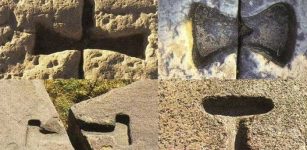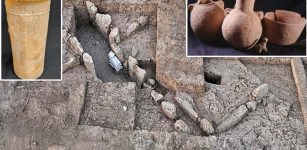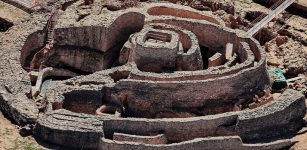Dracula: Cruel, Ruthless And Bloodthirsty Ruler But Not A Vampire
A. Sutherland - AncientPages.com - No doubt, the most famous and intriguing Romanian figure in both history and fiction is Vlad Țepeș (Dracula). Behind Dracula's renowned name is also the extraordinary life and times of the evil Romanian ruler from 1431 to 1476. His nickname is the Impaler.
Vlad used severe methods to restore order in a lawless state. He also had the courage to drive the occupation force, the Ottomans out of the country. But Vlad had a dark side… too.
He was regarded with great fear in many regions of Europe and Asia in the fifteenth century and strived to equal by many later rulers like, for example, Ivan the Terrible; Dracula did, in fact, exist.
He was also highly honored by his fellow citizens and is still even today.
However, he was not a bloodthirsty vampire but a Prince in Wallachia, a part of present-day southern Romania.
Vlad lived in Romania among many rulers and historical figures, surrounded by prejudices and controversies in the atmosphere of betrayal, conquest, and imprisonment.
As the author writes in "Captivating History; History of Romania, "the greatness of historic individuals cannot be measured through the prism of the modern age. To fully understand the actions and motivations of Vlad Tepes, Stephen the Great, and Michael the Brave, we have to understand that Romania was positioned between the Ottoman Empire and Europe, between the traditional East and the modern West. Just as the world was torn between the great powers, so were the rulers of Romania.."
Vlad Tepes (the Impaler)
His real name was Vlad III, but he was often called Dracula. Romania is full of ancient tales of the supernatural and legends of the unexplained, which have long influenced our imagination.
The Irish author Bram Stoker likely borrowed Vlad's name for his Transylvanian count in the book "Dracula" from 1897. We must remember that 'Dracula' is translated in Gaelic as Drac Ullah, which means 'bad blood.'
Vlad lived between 1431 and 1476 and is regarded as a national hero in his home country. He was considered a brutal and yet fair ruler.
During the 15th century, there was a struggle to obtain control of Wallachia, a region of the Balkans (Romania) that lay directly between the two powerful forces of Hungary and the Ottoman Empire. The power of the Ottomans seemed unstoppable.
Vlad used severe methods to restore order in a lawless state. He also dared to drive the occupation force, the Ottomans, out of the country. But Vlad had a dark side, too. He was delighted in torture and executions.
He was famous for slowly driving a pole through the bodies of his enemies while they were still alive. Vlad was a ruthless man, and his "methods" were brutal. Impalement was and is one of the most gruesome ways of dying.
His enemies feared Dracula, and he was called Tepes, meaning the Impaler.
It often took hours, sometimes even days, before the poor victim died on the pole. Later, the pole and the victim's body were publicly displayed. This horrifying sight was meant to serve as a warning to all Ottomans as well as different types of criminals, like thieves, murderers, and others.
The origin of the name Dracula has yet to be entirely confirmed. "Drac" means "devil" in the Romanian language and the ending "-uela" means "son of." We can assume that Vlad's nickname was "Son of the Devil."
Still, we must remember another essential aspect related to the origin of Vlad's name.
In 1431, Vlad's father was a member of the Order of the Dragon, a secret order of knights meant to protect the royal family from the invading Ottoman Turks.
The dragon was considered a symbol of the devil. Therefore, Vlad's name means "Son of the Dragon" or "Son of the Devil."
It is unknown why Bram Stoker used the name Dracula in his book, but there are two theories.
In 1890, Stoker borrowed the book "An Account of the Principalities of Wallachia and Moldavia," written 1820 by William Wilkinson. This book contains many descriptions of Dracula's life. Perhaps Stoker used this book as a source and inspiration for his novel.
Another possibility is that Stoker learned about Dracula through his friend Professor Arminius Vambery, whom he visited on several occasions in Budapest. Stoker mixed the history of Dracula's life with folktales of vampires, resulting in a classical book that is popular until today.
Dracula was a cruel, ruthless, and bloodthirsty ruler, but he was not a vampire. He is considered a national symbol of Romania's fight for independence against the Ottomans.
Written by A. Sutherland - AncientPages.com Senior Staff Writer
Updated on March 31, 2024
Copyright © AncientPages.com All rights reserved. This material may not be published, broadcast, rewritten or redistributed in whole or part without the express written permission of AncientPages.com
Expand for referencesReferences:
Keith Hitchins, A Concise History of Romania
Raymond T. McNally (Author), Radu R Florescu (Author), Dracula, Prince of Many Faces, 1990
Captivating History, History of Romania
More From Ancient Pages
-
 The Americas Were Not Populated Via The Ice-Free Corridor More Than 15,600 Years Ago – New Study Of Boulders Reveals
Archaeology | Mar 23, 2022
The Americas Were Not Populated Via The Ice-Free Corridor More Than 15,600 Years Ago – New Study Of Boulders Reveals
Archaeology | Mar 23, 2022 -
 Ivan The Terrible: Military Arsenal Unearthed Near Moscow
Archaeology | Jan 2, 2016
Ivan The Terrible: Military Arsenal Unearthed Near Moscow
Archaeology | Jan 2, 2016 -
 Statue Of Gudea: The King-Priest Of Sumerian City Of Lagash In Southeast Mesopotamia
Featured Stories | Aug 14, 2016
Statue Of Gudea: The King-Priest Of Sumerian City Of Lagash In Southeast Mesopotamia
Featured Stories | Aug 14, 2016 -
 First Insight Into 3,500-Year-Old Cuisine Of The Enigmatic Nok Culture
Archaeology | Jan 17, 2022
First Insight Into 3,500-Year-Old Cuisine Of The Enigmatic Nok Culture
Archaeology | Jan 17, 2022 -
 Drought Encouraged Attila’s Huns To Attack The Roman Empire – New Study
Archaeology | Dec 15, 2022
Drought Encouraged Attila’s Huns To Attack The Roman Empire – New Study
Archaeology | Dec 15, 2022 -
 Pre-Pharaonic Petroglyphs Used To Study Egyptian Cult Of The Gods
Archaeology | Mar 15, 2023
Pre-Pharaonic Petroglyphs Used To Study Egyptian Cult Of The Gods
Archaeology | Mar 15, 2023 -
 Radar Discovery Of Unknown Space Beyond Tutankhamun’s Burial Chamber May Lead To Queen Nefertiti’s Tomb
Archaeology | Feb 21, 2020
Radar Discovery Of Unknown Space Beyond Tutankhamun’s Burial Chamber May Lead To Queen Nefertiti’s Tomb
Archaeology | Feb 21, 2020 -
 Mysterious Cave Of Prophetess Cumaean Sibyl – Ancient Portal To The Underworld
Featured Stories | Dec 25, 2017
Mysterious Cave Of Prophetess Cumaean Sibyl – Ancient Portal To The Underworld
Featured Stories | Dec 25, 2017 -
 Aztec Treasure: ‘Yew Of Gold’ Found 39 Years Ago Originates From Spanish Plunder During ‘Sad Night’ In 1520
Archaeology | Jan 12, 2020
Aztec Treasure: ‘Yew Of Gold’ Found 39 Years Ago Originates From Spanish Plunder During ‘Sad Night’ In 1520
Archaeology | Jan 12, 2020 -
 Large 4th Century Mosaic Floor Unearthed In İncesu, Kayseri Province, Turkey
Archaeology | Nov 28, 2023
Large 4th Century Mosaic Floor Unearthed In İncesu, Kayseri Province, Turkey
Archaeology | Nov 28, 2023 -
 Owain Glyndwr: Famous Medieval Welsh Warrior Prince And Symbol Of Independence
Featured Stories | Jun 20, 2018
Owain Glyndwr: Famous Medieval Welsh Warrior Prince And Symbol Of Independence
Featured Stories | Jun 20, 2018 -
 Mystery Of Ancient Metal Clamps – Advanced Lost Technology Modern Science Still Cannot Explain
Ancient Technology | Jul 31, 2020
Mystery Of Ancient Metal Clamps – Advanced Lost Technology Modern Science Still Cannot Explain
Ancient Technology | Jul 31, 2020 -
 New Insight On What Ancient Noses Smelled
Archaeology | Mar 29, 2023
New Insight On What Ancient Noses Smelled
Archaeology | Mar 29, 2023 -
 Mythical Stymphalian Birds: Terrible Winged Maidens With Birds’ Feet
Featured Stories | Feb 27, 2017
Mythical Stymphalian Birds: Terrible Winged Maidens With Birds’ Feet
Featured Stories | Feb 27, 2017 -
 Great Serpent Mound Of Ohio: Most Famous Ancient Earthwork Of North America
Civilizations | Mar 17, 2014
Great Serpent Mound Of Ohio: Most Famous Ancient Earthwork Of North America
Civilizations | Mar 17, 2014 -
 Ancient 5,500-Year-Old Gate Was Discovered Recently At Tell Erani, Near The Kiryat Gat Industrial Zone, Israel
Archaeology | Aug 17, 2023
Ancient 5,500-Year-Old Gate Was Discovered Recently At Tell Erani, Near The Kiryat Gat Industrial Zone, Israel
Archaeology | Aug 17, 2023 -
 Motilla del Azuer: Impressive And Unusual 3,200-Year-Old Fortress
Featured Stories | Nov 13, 2018
Motilla del Azuer: Impressive And Unusual 3,200-Year-Old Fortress
Featured Stories | Nov 13, 2018 -
 Home Of The Gods – The Return Of The Gods – Part 3
Ancient Mysteries | Jun 14, 2018
Home Of The Gods – The Return Of The Gods – Part 3
Ancient Mysteries | Jun 14, 2018 -
 Lost Medieval Home Of The Lords Of The Isles – Reconstructed Virtually
Archaeology | May 29, 2019
Lost Medieval Home Of The Lords Of The Isles – Reconstructed Virtually
Archaeology | May 29, 2019 -
 Lady Cao – Moche Queen Who Re-Wrote Ancient History
Civilizations | Jan 12, 2018
Lady Cao – Moche Queen Who Re-Wrote Ancient History
Civilizations | Jan 12, 2018

